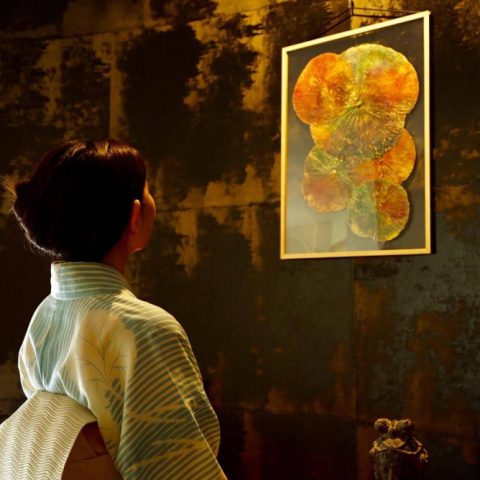
Have you ever thought about the story behind the tea you drink everyday? Yunomi.life is a Japanese tea brand with the inspiring mission to transcend cultural barriers by sharing the personal stories of local tea farmers in Japan with tea enthusiasts around the world.
We had the opportunity to speak to CEO and Founder of Yunomi.life, Ian Chun all about their artisanal Japanese tea and how he came up with such a unique concept.
Hi Ian! Can you please introduce yourself and tell us a little bit about how you came to found Yunomi.life?
Yunomi.life was created almost by accident. My wife was doing an MBA in the US, and I had quit my marketing job to join her, doing freelance consulting work on the side. A former colleague introduced me to a Kyoto tea farm, Kyoto Obubu Tea Farms, which was struggling to gain a foothold in the international market. I began helping them, then other tea farms, and by the time my wife and I returned to Japan, I had a number of small clients. Since they were small clients, it didn’t make sense to promote them separately — I would receive inquiries from the same buyer at all the farms’ websites — so I decided that an umbrella brand representing many farms would be more effective.

Image credit: Yunomi.life
Often, many people purchase tea without thinking too much about where it came from. What made you so interested in the personal stories of Japanese tea farmers?
I think because the origin of the business was as a consultancy helping tea farmers, rather than attempting to sell the tea that I liked myself, my interest skewed toward the people, their work, their lifestyles, their villages, their industry. I could never be a farmer myself, but I have a deep admiration for farmers. I also think that a healthy love for tea helped too; the drink has such a central role in Japanese culture. If the person I met 12 years ago was not a tea farmer from Kyoto, but a tomato farmer from Miyazaki, perhaps we wouldn’t be here today talking about this. I visited Kyoto a lot those first few years learning and learning and learning.
Your new ‘Women in Tea’ initiative is both groundbreaking and exciting. Can you tell us more about what made you want to focus your attention on women in the tea industry?
Hmmm….I wouldn’t call it groundbreaking, though I am honored by the term. It follows in the footsteps of so many other efforts in other industries. The effort is personal in origin; I made the decision years ago to support my wife by taking primary responsibility for housework and childcare—so that she could do what was necessary for her career whether that meant coming home at midnight every day or relying on me to take care of our son when he got sick. In discussions about gender equality, about the advancement of women into management, so much is made of freeing women from their responsibilities at home, but what we (men and women alike) ask of husbands and fathers here in Japan is so little.
So I come from a personal background of concern for women in the workplace, and I have known about how male-dominated the tea industry is for many years. I have personally met women in the Japanese tea industry who experienced gender discrimination. I’ve wanted to do something myself for many years, but it always seemed a little inauthentic for a man to start such an effort. But it isn’t about who leads the effort as much as what results, and the result that we want is a change in how women are seen by the industry internally. Farming and production is physically strenuous labor, and even today, there is a misplaced chivalry (in cases where intentions are benevolent, but ugly disdain where they are not) in Japan that steers the “weaker sex” away from those roles.

Women tea farmers from Kiyosawa Tea Gardens. Image credit: Yunomi.life
The Women in Tea program starts with tea made by women running their own tea farms and factories, those women who have succeeded in swimming against the flow of opinion against women as producers and business leaders. There are not many of them. So for there to be more, I think we need to start by changing opinions industry wide, to start mentoring women to be future factory managers, future lead farmers. So, for example, the Kiyosawa Tea Gardens brand is one that Yunomi created to bring together tea from women in the Kiyosawa Village of Shizuoka. These women didn’t necessarily make the tea all by themselves without their husbands, but like so many small family farms, they (and society at large) consider their husbands the farmers, while they are proudly “farmers’ wives”. In fact, there are more women working in this way in Japanese agriculture than men now, but they remain largely invisible because their husbands’ names are registered with the local coops, their husbands’ names are on the bank accounts accepting payments. I suggested that though they married into the farming family, after decades of working side by side with their husbands, they are themselves farmers in their own right.
Yunomi is still a small company, so I don’t believe our effort will change the industry in the short term. But hopefully we can provide a bit of a spotlight onto this issue.
Your concept rests a lot on bridging cultural barriers and bringing tea drinkers from around the world together. Why is sharing Japanese tea culture internationally so important to you?
On the business side, the Japanese tea industry is in decline. That’s hard to imagine with so much buzz in the West (and recently Southeast Asia too) around matcha, but when you look at the statistics, it’s pretty obvious. Part of the reason is that the agricultural workforce is aging and so much of Japanese agriculture is made up of family-operated farms. Children have taken jobs in other industries, and there is no pressing need for any individual farm to continue. The number of tea farms in Japan was once over 200k in the 1980s and has shrunk to 12k in the last census in 2020. The market for Japanese tea is 95% domestic, and that domestic market has shifted to drinking green tea out of a plastic bottle—tea that is cheap and mass-produced. The decline in average prices leaves little reason for families to continue farming.
And this means a loss of culture. While I abhor the image of women making tea for visitors to a company while men have their business meeting, today if you visit a company, more likely than not they’ll provide you with complimentary tea in a plastic bottle. Japan is a coffee nation today; Japanese drink perhaps 4-5 times more coffee than tea. This loss of culture scares me, to be truthful. If we can grow demand for Japanese tea outside of Japan, that could provide significant support to this declining industry.
I believe that Japanese tea eventually will fall into an equilibrium resembling the Champagne industry which is a small but premium niche in the wine industry and which exports a significant percentage of production. Personally, Japanese tea has also been a focal point for me to study and share the culture of my adopted home. In sharing information about a tea product or producer, I can tell stories about the history and culture of a region.

Saitama-based award winning farmer Okutomi Mashiro, a Yabukita cultivar tea field being shaded for extra umami flavor and groomed for hand picking. Image credit: Yunomi.life
What makes Japanese tea so special? How does it differ from other tea around the world?
Less that 2% of the tea produced globally is produced in Japan, and only about 5% of Japanese tea produced is exported. That situation itself makes Japanese tea rare outside Japan. I would not say extremely rare, because most tea companies around the world do sell some Japanese tea, but because their customers are not buying it frequently, the turnover is low and often their stock is old (even if it was good to begin with).
But Japan has been cultivating and processing teas independently for hundreds of years. Tea first took hold in Japanese society in the late 12th century when Buddhist monk Eisai brought it back from Song Dynasty China. At that time, tea was processed into cakes (like puerh tea today). Pieces of the tea cake were then chipped off to be ground into powder, and then mixed with hot water to be consumed as a medicine. This form of tea preparation disappeared in China, but continued to be developed over the centuries by the Japanese into what would become wabicha in the 16th century, and then into what we today call Chado (literally the “Way of Tea” or the Japanese tea ceremony).
Japanese tea farmers and producers also developed new techniques to process tea—most notably, the steaming leaves during processing. While the oxidisation of tea (we used to call it fermentation), became the dominant form of tea for export from China, later India, to Europe, the Japanese pursued tea that was meant to be fresh. The steaming of the leaves after harvest produced a leaf that was deeply green and retained the freshness of the original leaf. Called Sencha, this steamed tea is unique to Japan.
You must have learned a lot about the history of tea in Japan. Could you share the most compelling thing you’ve learned about the industry and its rich past?
One of the most interesting things I have learned about the history of tea in Japan is the role of Chado, or the tea ceremony. When the formalization of the ceremony took hold during the 16th century, it became a sort of status symbol to the elite members of Japanese society. Merchants pursued the perfection of the practice of making tea, and sold the most prized, valued items to powerful members of the feudal government. We have a strong image of the ceremony in connection with Buddhism and an image of it being practiced with monks because so many elite members of the low-ranking but wealthy merchant class would become monks to gain an audience with the aristocracy.
And, the lasting cultural importance of Chado might perhaps be attributed to one merchant, Sen no Rikyu who became not only the official tea master but also a top political advisor to Toyotomi Hideyoshi, one of the most powerful lords of the 16th century. His official position as tea master but unofficial position as a powerful political advisor certainly encouraged the practice of Chado among the elite throughout Japan. History isn’t so simple of course, but it’s fascinating to try to unravel the tangled webs that the passage of time leaves to us.

The Kinezuka family in Fujieda, Shizuoka, has been with us from the start — ten years ago. Image credit: Yunomi.life
How do you find such rare and unique types of tea? Do you have certain criteria? What draws you to a type of tea or a particular farm?
I start with the knowledge gained over a decade in this industry and look out for those practicing unique techniques. The pandemic has forced me to rely on web-based information more than in the past. Often a primary producer does something interesting but doesn’t have the ability to make their innovation known as the complexity is lost in the supply chain. Going directly to the source to find out why a tea is unique is a lot of work but very rewarding.
The story of the producer is what draws me the most. The romance is part of the reason why connoisseurs are drawn to tea, and so I tend to look for those producers who are good at telling their stories. Occasionally you do find a great tea without a good story, and then it’s often a matter of prying the story out of the producer. They may have the most terrible website, or none at all, and their marketing material might say “This tea ….tastes great!” and nothing more. Too often, middlemen don’t intend to tell their stories so don’t bother asking, and so the producers — farmers or factories — don’t realize how important it is to the connoisseur.
One of the most interesting teas we sell is a green tea that has been fermented with kurokoji, the fermentation starter used for Japanese sake. This tea, produced by Osada Tea in Shizuoka, creates an earthy tea with notes of strawberries and cranberries.

You also have blog articles featuring delicious recipes which incorporate tea. Do you recommend any in particular?
I have been experimenting a lot with Hojicha as a base for lattes. I am still working on it, but I think hojicha would also make an interesting base for an Indian-style chai.
Of course we have to ask – what’s your favorite type of tea to drink? Do you have a favorite Japanese snack to pair it with?
I change from time to time. Right now, to be truthful, I am personally hooked on smoked black teas and pair them with whisky actually.
As a culinary tourism company, we always love to recommend unique experiences around Japan. What would you suggest for tourists who are looking to do something new and exciting? It can either be tea related or just a general cultural experience you think is a must.
I highly recommend visiting a tea village — Wazuka in Kyoto, Higashiyama in Shizuoka, Yabe Village in Fukuoka — and just walk around. There are cafes you can visit in these places, some that used to offer walking tours even (pre-pandemic), but if not, a hike through the village is wonderful. They’ll often have unmanned kiosks where you can buy local produce by putting money into a box (on your honor!).
Thank you so much for taking the time to introduce us to your brand, it’s been incredible to learn all about local Japanese tea and the farmers who contribute so much to the industry!
Follow them on:
Website: https://yunomi.life
Instagram: @yunomitea
Facebook: @YunomiTea
Twitter: @YunomiTea
Youtube: @Yunomi
Pinterest: @yunomitea
Featured image: Yunomi.life
Learn more about Japanese Tea on our Green Tea Online Experience!




